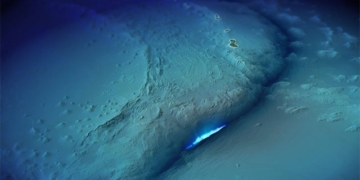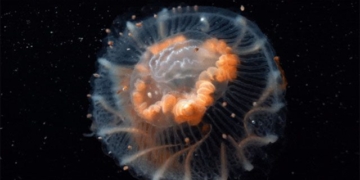In North America, there have only been two instances of captive narwhals, both of which ended poorly.
The narwhal (Monodon monoceros) is a species of toothed whale that inhabits the icy waters near the Arctic. They typically measure between 3.95 and 5.5 meters in length, not including the long, spiral tusk that protrudes from the head of males and some females, resembling a unicorn’s horn. Their shy and easily frightened nature makes them relatively difficult to study. As a result, many aspects of their behavior remain a mystery.

The narwhal is named for its long tusk that resembles a horn protruding from the heads of males and some females. (Photo: Dotted Yeti).
Despite the challenges, the New York Aquarium, located in Coney Island, became the first aquarium to house a narwhal in 1969. The young narwhal was named Umiak, after a type of Inuit boat traditionally used for hunting this species in the Arctic. The animal was captured by Inuit hunters, who reported that Umiak followed their boat back to camp after they killed its mother for meat.
To prevent Umiak from being lonely, it was placed in a tank with a white female whale, likely a beluga whale. The beluga served as a “step-mother” to the narwhal. Aquarium staff fed the narwhal a large amount of milk mixed with chopped clams each day, which seemed to satisfy the animal. However, Umiak’s time at the aquarium was tragically short. On October 7, 1969, less than a year after its arrival, Umiak died from pneumonia, according to The New York Times.
The second instance of narwhal captivity occurred at the Vancouver Aquarium in Canada. In 1968, aquarium director Murray Newman hoped that bringing a narwhal to the city would generate public interest in this mysterious species, aiding in its conservation.
In 1968, Newman and a team of sailors, guided by an Inuit guide, traveled to the waters near Baffin Island to capture a narwhal, but their two-week hunt was unsuccessful, according to the Vancouver Sun. Newman returned to the area in 1970 for another hunting expedition that lasted three weeks but also failed. Eventually, they purchased a young male narwhal from a group of Inuit hunters in Grise Fiord.
The animal was named Keela Luguk, derived from the word “qilalugaq”, the Inuktitut term for narwhal. Keela Luguk arrived at the Vancouver Aquarium in August 1970. Within a week, the facility also captured two female narwhals and three calves, which were placed in the tank with Keela Luguk.
Initially, the event was celebrated by the public and the media, but things quickly took a turn for the worse. Within less than a month, by September 1970, three calves had died. By November, the two females also perished. Public outrage began to grow, and the mayor of Vancouver called for Keela Luguk to be released back into the wild, but Newman opposed this. Ultimately, on December 26, Keela Luguk also died.
Experts are unclear on the exact reasons why narwhals do not thrive in captivity. Their closest relatives, the beluga whales, are commonly found in aquariums and have relatively long lifespans.
However, it is evident that narwhals are extremely sensitive. Their characteristic “tusk” contains 10 million nerve endings that help detect subtle changes in temperature, pressure, and other factors. Studies have also shown that this species is particularly sensitive to artificial noise. The passage of a single ship through their habitat can lead to significant behavioral changes.
In recent years, public awareness regarding the captivity of marine animals has shifted. It is unlikely that the world will make another attempt to capture narwhals for display in aquariums. The failures of the previous two efforts suggest that this is good news for them.


















































